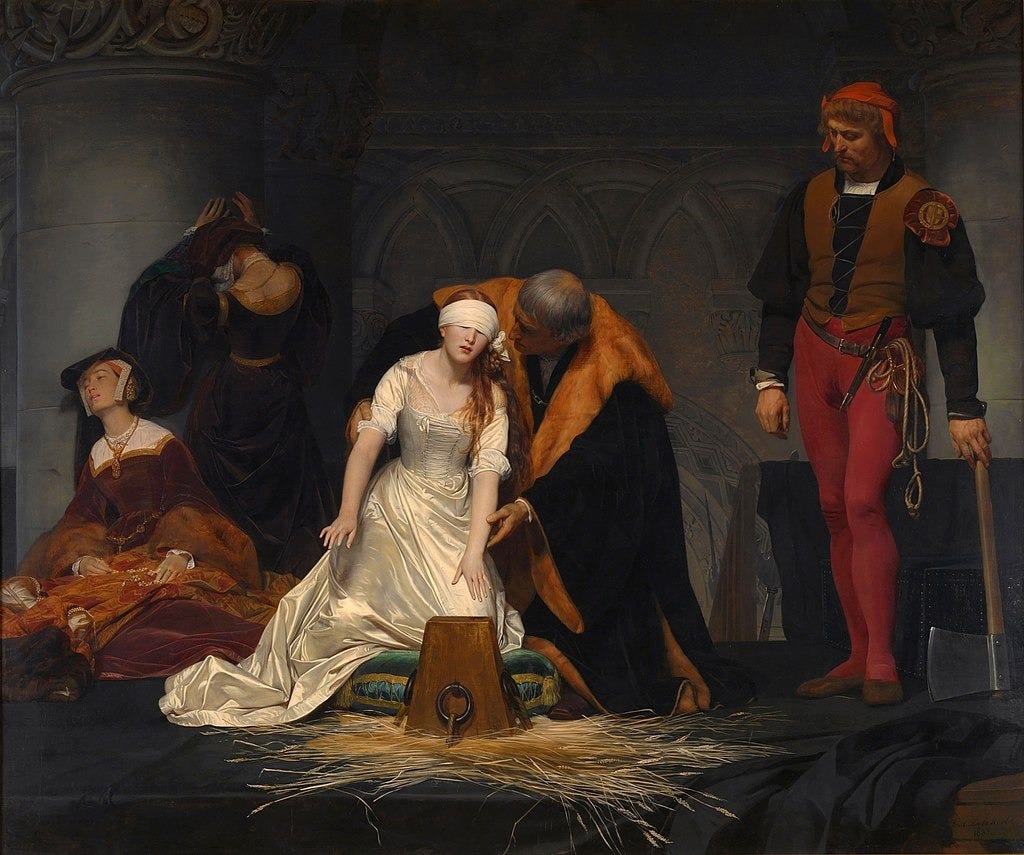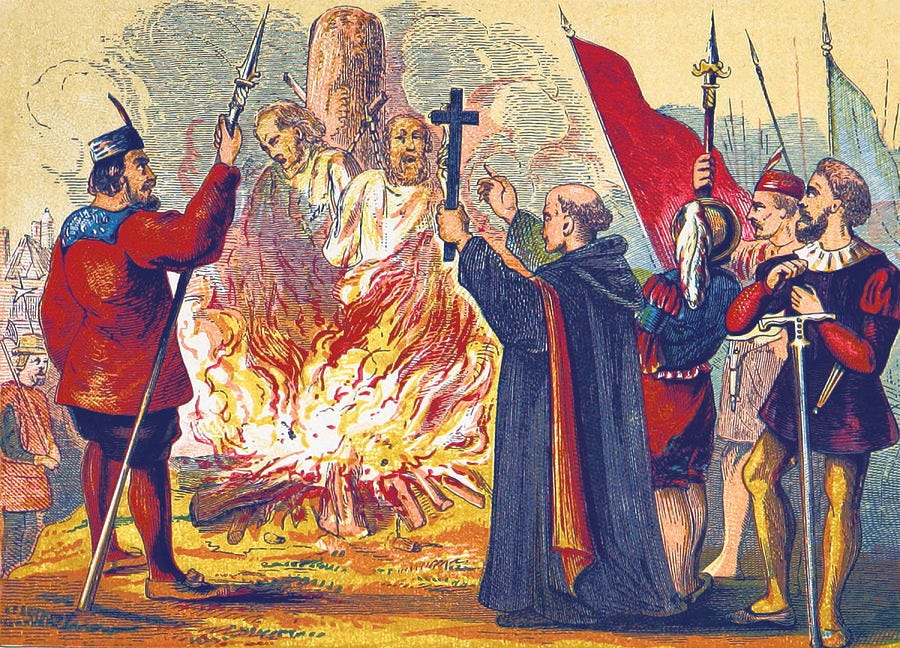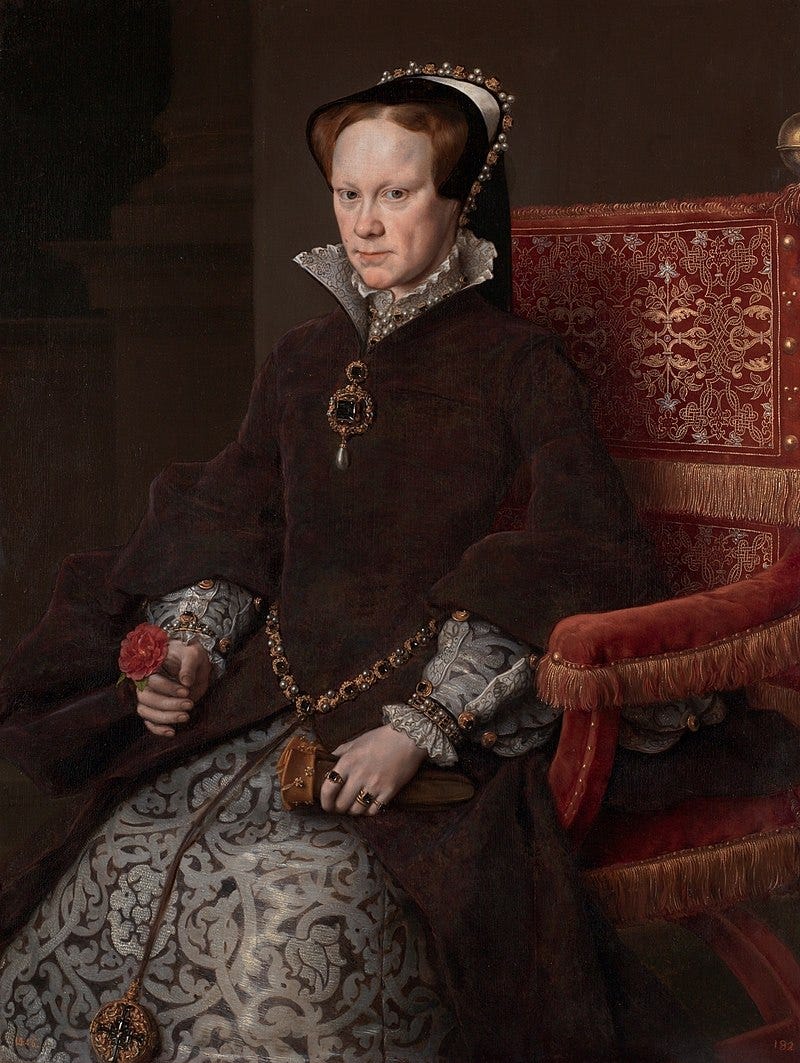All the Marys, Catherines and the odd Jane: Part One
A who's who of Tudor women starting with Blood Mary
Last year I saw Six the Musical with a gaggle of friends for my best friend’s birthday. As a fan of musicals and history, this intersection of interests naturally excited me. A few weeks later one of the friends in the group reached out to me and explained they were a little embarrassed by how confused they were by the Tudors. Who were all these Marys? She asked. Who did what? She was asking me because some of us Brits at school didn’t get entirely bored with the Tudors being burned into our brains relentlessly year after year. I know that some of my friends struggled with history because they couldn’t visualise it. Teachers didn’t paint pictures or encourage children to imagine what it was like to be in their shoes. It was all facts and figures and dates. I always had a vivid and overactive imagination so this was not the case for me.
In my spare time I watched movies about them, the accuracy of which I started researching and this gave way to watching more movies, books and documentaries. In response I sent my friend over an hour’s worth of voice messages explaining passionately and quickly who came first, who they married, what they did, how they died etc.
The first question I answered for her was the difference between Mary Queen of Scots and Bloody Mary.
Glossary:
Regnant - ruling monarch, monarch by blood and not marriage
Regent - Family member or guardian who rules on behalf of the rightful monarch who is too young or unfit to rule
Consort - the spouse of a ruling monarch
Bloody Mary, AKA Mary Tudor, was Henry VIII’s eldest daughter by his first wife, Catherine of Aragon. Catherine was a Spanish princess who was a few years older than Henry when they married as she was originally betrothed to Arthur, his older brother, and married for six months before he died young (debate still rages as to whether they, as royal teenagers, did or didn’t have sex, a point that proves to be crucial in future divorce proceedings). Catherine, desperate to secure an alliance between England and Spain, campaigned hard to marry Henry and succeeded. Aside from a lot of devastating miscarriages and infant deaths, by most accounts they had a happy marriage, to a point. Catherine was loved by the people, not least because of her charitable works, including alms giving, but once, while the king was away she marshalled an armed force to defend the kingdom from an insurrection. During this time, Mary was a darling of the court and as devoutly Catholic as her mother. Then her father met Anne Boleyn.
Unfortunately, Catherine was unable to provide Henry with a male heir which was grounds for divorce by Henry’s standards. Watching your father brutally divorce your mother, changing the religious and political landscape of an entire country to do so and delegitimising your birth and path to the throne, is pretty traumatic to say the least. Safe to say it was an experience that Mary never forgot.
Fast forward to Henry’s death, by which time Mary’s mother had died (her autopsy revealed a black heart suggesting she might have been poisoned) and she has a half-sister and half-brother, both of whom have been raised Protestant. Now when I say devout, Mary is hardcore devout, so devout that it will lead to the moniker by which we know her today. After her little brother Edward ascends their father’s throne at the tender age of 9 and dies only a few years later, Edward’s nearest and dearest want a Protestant to succeed him, not Catholic Mary who might turn back the clock and make the whole country Catholic again. Yet for some reason they ruled out Elizabeth as an option and went for a Protestant cousin, Jane Grey.
You might have heard of poor Lady Jane Grey. She was Queen for nine days and only nine days because of Mary. One of the first bloody acts of her career came after rallying support for a coup, involving marching her supporters to London to overthrow the Protestant government, when she had Jane Grey executed. Jane Grey isn’t depicted as having much agency probably because she is 16 years old. She is usually described as a pawn in the Protestant faction, hence the sympathy toward her. Mary could have agreed to her imprisonment or exile. Alas, she didn’t. Thus beginning the reign of Bloody Mary.
One of the things I find fascinating about history is how repeats itself, the poetic irony that comes swiftly or generations later. Ten years prior, her father, Henry, was persecuting radical protestants and ten years before that he was persecuting die-hard Catholics. Henry was a fickle narcissist and this isn’t just reflected in his relationships. He swung like a politician from right to left to centre then back to right again. He died just right of the centre, restoring some Catholic ideals but remaining Supreme Head of the Church of England. In a way, Anne Boleyn was the 16th Century Eve, Henry was Adam and the Divine Right of Kings was the apple. Oof, did that backfire.
Suffice to say, Mary did her darnedest to restore Catholicism to Britain. She re-established relations with the Pope and the Catholic nations of Europe, she married Philip II of Spain (her first cousin once removed), reversed Protestant policies and began her persecution of Protestants. Over 5 years she killed hundreds of men, women and children (Jane Grey was 16 so a child), burning a lot of them at the stake, not unlike her father. One of whom was Thomas Cranmer, appointed Archbishop of Canterbury by her father during the Reformation and who blessed her parents’ annulment and Henry’s marriage to Anne Boleyn. Although her ascension was originally celebrated, her popularity plummeted once she ramped up her killing spree, inciting widespread fear and hatred for her. She also suspected her sister Elizabeth of being involved in a plot to overthrow her (Wyatt’s rebellion) and threw her in the Tower for a while.
Fortunately for Protestant survivors, her reign was a short one as she died in 1558. Of what, you might ask? After all, a lot of historic figures from this time seem to be lucky to make it to 50. Having married Philip II in 1554 at the age of 38, she hoped it wasn’t too late to produce an heir (geriatric pregnancies were very rare at this time) but in 1557 she was pregnant. However by the tenth month of her pregnancy, everyone realised she was not pregnant. She may have experienced a phantom pregnancy in 1555 but that’s not what this was either. She was actually suffering from either ovarian cysts or a uterine cancer.
Her marriage to Philip II was as unhappy as it was short. He was rarely in England, disenchanted not only with his wife’s fertility but that he was jure oxoris King of England; he only had the powers of a consort, not the powers of a King. Despite this and aware that his wife was dying, he reached out to Elizabeth and proposed marriage to her. Some power is better than none, after all. Elizabeth said no and in thirty years he would launch a naval attack against Elizabeth and England. But I digress.
So to recap, Henry dies in 1547, Edward VI (his son) dies in 1553, Lady Jane dies in 1553 and Mary dies in 1558. My penchant for dates and pattern recognition finds it fascinating (autistic much) that in 11 years the country had four monarchs!
Now should you wish to know more about Mary I, you may contact me and if I don’t know the answer, I’ll find out. Alternatively I encourage you to do your own research (more than scrolling through Wikipedia). But consider yourself vaguely schooled on Mary Tudor, the first undisputed Queen regnant of England.
Post Script - Highly recommend seeing the musical Six! As well as watching the following movies; Elizabeth (1998), Elizabeth the Golden Age (2007), The Other Boleyn Girl (2008), Mary of Scots (2018), Firebrand (2023) and watching the following series; The Tudors, White Queen, White Princess, The Spanish Princess, Elizabeth (2022) and listening to the following podcasts; Betwixt The Sheets.




